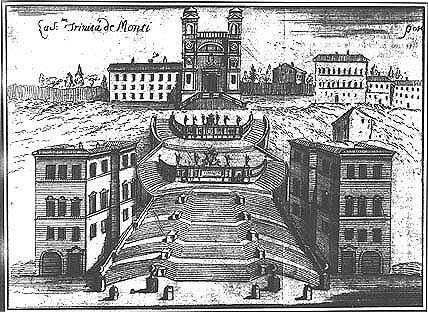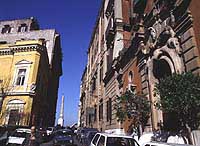Piazza di Spagna

Church of Trinità dei Monti
(1495). King Charles VIII of France founded this church after a trip to Rome. Its location is breathtaking and its architecture French, with dazzling paintings by Federico Zuccari (1540-1609).
The Church is part of the next door Convent of the Minims - Order of the Sacred Heart, founded in 1494 on the site of Lucullus' 1C BC palace. Ironic that this Minim order (perpetual Lent for them) should be on this maximalist site. Lucullus was famous as the greatest gourmet and gourmand of Caesar's time. At his table you sampled roast swan, oysters from Colchester, England (brought by relays of runners in 4 days) plus exotica of every sort, including theatrical interludes between courses. He gave us the word Lucullan, still used to describe a fabulous feast.
When deathly ill, Louis XI (1423 - 1483) was nursed back to health by the monks of this order, all French. He helped them found the Convent: the start of French influence in what is misleadingly called the Spanish Steps area.
Today there is a French school in the garden.
Fontana della Barcaccia
(Barcaccia Fountain) (1629, Pietro Bernini).The father of the great Bernini designed this fountain as a sinking boat partly because the Aqua Virgine Aqueduct water pressure was low and partly because a boat was once washed up here when the Tiber River overflowed. (Keep your eyes skinned for nearby high water markers commemorating the river's rage).
The accessibility of this beautiful "boat" makes it one of the most popular fountains in the city.
Casa di Keats e Shelley
(Keats and Shelley Memorial House) (Early 18C). Coming here with his friend the painter Joseph Severn in 1820, Keats hoped the dry (!) Roman air would cure his tuberculosis. He was depressed by criticism of his poetry, and by the distance (both miles and her indifference) between him and the girl he loved. He coughed his way to death - which followed swiftly, in this house early the next year. He was 27.
Shelley was inspired to write a poem lamenting the death of his friend Keats, but he, too, died young in a boating tragedy near La Spezia a year later in 1822, leaving his disconsolate widow Mary Woolstonecraft, author of Frankenstein.
Their fellow Romantics Byron, Browning, and Tennyson all came to Rome for inspiration, delving into the classics, and soaking up Rome's ancient beauty. The Museum has a good library, Keats' death mask, engravings.
Open: 9 am -1 pm and 3 pm -6 pm Monday to Firday. Saturday 11am -2pm and 3-6pm. Closed Sunday and public holidays
Villa Medici
(Annibale Lippari 1564). A Renaissance Palace, now the home of the French Academy. The fact that its outer walls slope in the Medieval fashion only serves to make this massive building seem more sober than it is. The rear facade overlooking the vast grounds has an ornate loggia surrounded by bas-reliefs and statuary. The fountain in front came from the Baths of Caracalla.
|
Villa Medici
History I C BC. Part of Lucullus' grandiose gardens. 1560. A simple country home made for Cardinal Crescenzi. 1564. Cardinal Ricci of Montepulciano bought it, hired the architect Annibale Lippari and transformed it into a Fortress on the outside, and a pleasure palace on the inside. As President of the street, Ricci had Via Sistina paved for his own convenience. 1576. Bought by Cardinal Ferdinando de' Medici of the Florentine Papal family. 1630. Velazquez stayed here. Later that year Galileo started a 3 year confinement at the invitation of the Inquisition. 1666. Louis XIV founded the French Academy for students of art to study in Rome. They included Fragonard. Boucher and Poussin, who won the Prix de Rome. 1803. Napoleon moved the Accademie Française here, widening the scope to include engravers and musicians. Later, Debussy and Berlioz were students. The lucky students, selected by the French Ministry of Culture come here for a couple of years to study classical culture, plus such new subjects as literature, film and art restoration. |
Viale Trinità dei Monti, 1. Tel. 06 67611 (Map H 1) Open Saturday and Sunday for guided tours at 10:30 and 11:30 am.
There are periodical art shows here as well as Summer music and ballet festivals in the garden
Palazzo della Maschera Grottesca
 (Palazzo of the Grotesque Masque) (1591 Federico Zuccari)Just nip down to Via Gregoriana and revel in this fabulous facade. Anyone who doesn't enjoy this artist's house needs his head examined!
(Palazzo of the Grotesque Masque) (1591 Federico Zuccari)Just nip down to Via Gregoriana and revel in this fabulous facade. Anyone who doesn't enjoy this artist's house needs his head examined!
The Monster's mouth is the front door, and 2 windows are situated in the surprised eyes.
Federico, the younger of the 2 famous painting brothers, built this to house a painting school. Don't miss his paintings in the nearby Trinita dei Monti Church.
Now it is the Herzian Library, a German cultural center. Not open to the public.
Collegio di Propaganda Fide
(1622, Bernini and Borromini). The two rival geniuses of Roman Baroque architecture designed various parts of this pile, but with indifferent results. The facade over the Piazza is signed Bernini, whereas Borromini designed the convex and concave entrance facing Via Propaganda - in 1667 just before he committed suicide.
Column of the Immacolata
(Colonna dell'Immacolata). In 1857 Pope Pius IX, despite the almost unanimous opposition of his advisors, proclaimed that the Virgin Mary was herself in effect the product of a virgin birth. Fittingly, he commemorated this controversial dogma with a statue of the Virgin placed on top of an ancient Roman (pagan) column.
The event is celebrated every 8 December when the mayor of Rome (Communist in recent years) and the Pope meet here amidst public rejoicing.